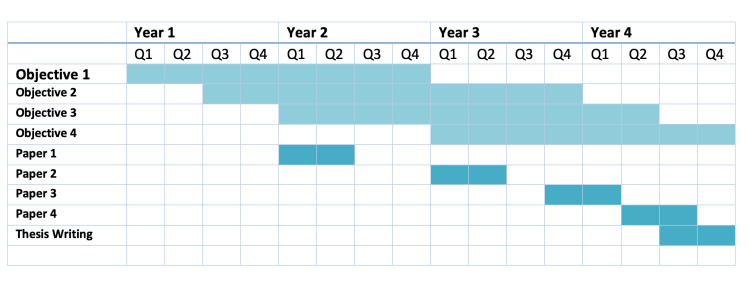Jo Duyvestyn

Project
Track: 25, Arbovirus pathogenesis and development of innovative vaccine candidates
Tags
Promotor
prof. dr. Eric Snijder
Primary Supervisor(s)
dr. Martijn van Hemert, dr. Marjolein Kikkert
Co-Supervisor(s)
dr. Barry Rockx (Erasmus MC)
Institute
LUMC
Description PhD project
My research sits within the work packages aiming to provide an integrated approach to intervention development. More specifically the goals of this project are to characterise the phenotypes of Usutu Virus (USUV) variants using reverse genetics, based on both rational design and variants identified in field studies. The mutants will be studied to assess their transmissibility, virulence and immune evasion capabilities and the molecular determinants involved. Results from these studies will be applied to create attenuated designs for use in a range of vaccine platforms. The scope of this project also includes using these tools to study West Nile Virus (WNV), and the potential to incorporate other arboviruses with risks of emergence in line with a proactive one health approach.
Research questions / objectives
- Do different USUV variants display different interactions with the host immune response, and what viral determinants are involved?
- What are the characteristics of USUV variants with different pathogenicity phenotypes in cell culture and animal models, and what host factors are involved?
- Can the information from Part One inform us on how to attenuate the virus in a way that is applicable to vaccine platforms?
- How efficacious are the vaccines in an animal model?
Timeline

Tags matching with the contents of track 25
Methods
-
Labwork
- PCR: PCR will be used in amplification of samples, confirmation of cloning, and ….???
- RNA/DNA extraction: Purifying infectious clone or expression construct plasmids from growth cultures, or RNA from cell supernatants when growing virus or clones.
- Virus neutralization: Will measure neutralizing antibody titres of vaccines that we test in animal models
- In vivo: IFNAR-/- mouse models to look at pathogenesis of mutant USUV clones, and vaccine testing.
- In vitro: Range of cell lines models including Vero/BHK to grow/optimize virus, immune competent human cell lines to study immune evasion and pathogenesis of mutants, mosquito cell lines including C636 (and a culex line?) for characterisation of mutants.
- Next generation sequencing (NGS): To confirm the sequences of our clones and mutants
- Molecular Cloning: To create an USUV infectious clone and expression
- Ex Vivo: As a model to study pathogenesis of mutant constructs, likely in collaboration
- Plaque Assay: Will be used to charactorise WT, infectious clone, and mutant USUV (and other?) viruses.
Literature
- Literature review: Likely will write this on comparing virulence factors of flaviviruses in a vaccine design context
Topics
-
Vector
- Vector competence: Could in interesting in collaboration with others to look at vector competence of mutated clones.
Host:
- Host immune response: Comparing the innate immune response of mutated proteins and clones, and of potential vaccine candidates
Virus
- Pathogenicity: Compare this for different mutant proteins, clones and vaccine candidates in vitro and in vivo.
- Virus-host interaction: Compare this for different mutant proteins, clones and vaccine candidates in vitro and in vivo.
- Mutations: Will be creating mutant expression constructs for the virus proteins, and mutated infectious clones with the goal of attenuation. These will be based on variants found in the field and rational design.
Interventions
- Vaccines: Will use attenuation information in a range of vaccine platforms including MLV and YF17D Chimera. For USUV, possibly other viruses, and to look at cross reactivity.
- Preparedness: Creation of vaccine candidates, possibly design of novel platforms, and maybe asking how broadly does attenuation information apply to other potentially emerging flaviviruses, or what their cross reactivity looks like?
Species
-
Species:
- Human: Vaccine development, innate immune evasion information.
Virus
-
Virus:
- Virus (general): Will be working with live viruses and infectious clones both in vitro and in vivo.
- West Nile virus: Will be working with live virus (and possibly infectious clones) both in vitro and in vivo, as comparison for USUV and cross0reactivity studies.
- Usutu Virus: Will be working with live virus and possibly infectious clones both in vitro and in vivo, as well as mutant constructs.
- Japanese Encephalitis Virus: Possibly – scope could encompass working with live virus (and possibly infectious clones) both in vitro and in vivo, as comparison for USUV and cross-reactivity studies.
- Dengue Fever Virus: Possibly – scope could encompass working with live virus (and possibly infectious clones) both in vitro and in vivo, as comparison for USUV and cross-reactivity studies.
- Yellow Fever Virus: Possibly – scope could encompass working with live virus (and possibly infectious clones) both in vitro and in vivo, as comparison for USUV and cross-reactivity studies.
- Zika Virus: Possibly – scope could encompass working with live virus (and possibly infectious clones) both in vitro and in vivo, as comparison for USUV and cross-reactivity studies.
- Tick-Borne Encephalitis Virus: Possibly – scope could encompass working with live virus (and possibly infectious clones) both in vitro and in vivo, as comparison for USUV and cross-reactivity studies.
- Chikungunya Virus: Possibly – scope could encompass working with live virus (and possibly infectious clones) both in vitro and in vivo, as comparison for USUV and cross-reactivity studies.
- Sindbis Virus: Possibly – scope could encompass working with live virus (and possibly infectious clones) both in vitro and in vivo, as comparison for USUV and cross-reactivity studies.
- Mayaro Virus: Possibly – scope could encompass working with live virus (and possibly infectious clones) both in vitro and in vivo, as comparison for USUV and cross-reactivity studies.
- Rift Valley Fever Virus: Possibly – scope could encompass working with live virus (and possibly infectious clones) both in vitro and in vivo, as comparison for USUV and cross-reactivity studies.